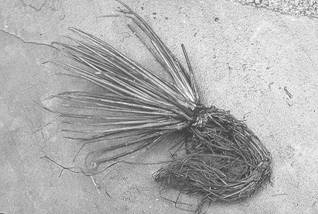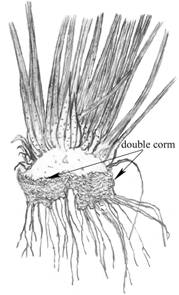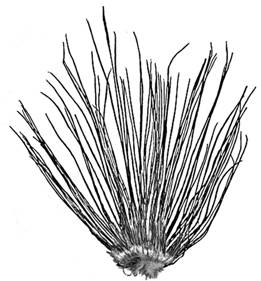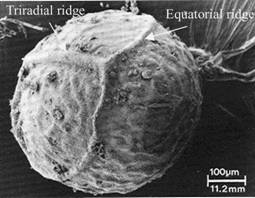Prototype quillwort (Isoetes prototypus) COSEWIC assessment and status report: chapter 3
Species Information
Name and classification
Scientific name:
Isoetes prototypus D.M. Britton
Common name:
Prototype Quillwort, Big Quills, Spike Quillwort
Family:
Isoëtaceae (Within the order Isoëtales Engler, there is but one genus, currently represented by 143 species and 15 hybrids, although some Isoetes authorities have stated that there may be 300+ species of Isoetesin the world.)
Bibliographic citation:
D.M. Britton and J.P. Goltz (1991). Isoetes prototypus, a new diploid species from eastern Canada. Canadian Journal of Botany, Vol. 69: 277-281.
Synonymy:
Plants of this species had not been recognized as a species new to science until 1988, but had been previously collected and/or identified under a variety of names, e.g., I. lacustris (including Isoetes macrospora? and I. hieroglyphica); I. tuckermanii; I. acadiensis; I. riparia; and Isoetes sp.
Genetic links?:
Based on very preliminary DNA sequence data, it appears that the I. prototypus genome is present in Isoetes tuckermanii, I. acadiensis and I. lacustris (Taylor pers. com. 2003).
Status:
Leading Isoetes researchers (Britton 2002, Brunton 2002, Caplen and Werth 2000, Hickey 2003, and Taylor 2003) affirm that Isoetes prototypus is indeed a valid species, based on its chromosome number (2n = 22), its spore morphology, its isozyme patterns (Caplen and Werth 2000), its invariably straight leaves, its deep water habitat and several rather unique anatomic features, including a distinctive ligule and pronounced labium (Hickey 2003).
Morphological description
(For more technical details see Britton and Goltz 1991.)
Isoetes prototypus (Figure 1) is a diploid species (2n = 22). It is perennial, and has a bilaterally symmetrical two-lobed (rarely three-lobed) corm (Figure 2) that bears 10-25 (-75) leaves, ranging from 4-12 (-15) cm long (Figure 3). The leaves are very straight, rigid, quill-like and brittle, abruptly tapering from a swollen base and then gradually tapering to a sharp tip (Figure 4). The leaf colour is mainly dark green except for the reddish brown or chestnut-coloured base. There is still some debate as to whether or not this species has a velum. Spores are borne in the swollen bases of the leaves. The female spores (megaspores) are white, 425-575 (mean = 500) µm in diameter, and levigate (fairly smooth) with low meandiform markings sometimes reduced to mere molded mounds, and very pronounced triradial (three-spoked) and equatorial ridges (Figure 5). The ornamentation continues to the equatorial ridge (the “girdle”). The microspores are pale brown, lenticular (monolete), 23-32 (mean = 28) µm in length and covered with a complex network of spinulose fibres (Figure 6). Spores mature in summer (Britton and Goltz 1991).
Figure 1. I. prototypus habit, x 0.3 (D. Vail photo).


Figure 3. Isoetes prototypus habit, from floating plant with no roots, x0.5 (drawing G. Bishop).




When viewed from above, the largest plants of I. prototypus have crowns measuring 8.5 x 20 cm with a resulting oval shape, being somewhat laterally compressed.
Although identification of I. prototypus is most reliably based on spore morphology and chromosome numbers at this time, helpful macroscopic characters that resulted in an accurate identification of most plants of this species in the field were as follows:
- The “quills” are straight, stiff and very brittle, often breaking when pressure (e.g., from an outstretched hand) was applied by pushing downward on the tips of the leaves. Other taxa with straight quills, I. lacustris and plants of I. x harveyi with the I. x heterospora morphology, tended to flex considerably (almost like an archer’s bow), rather than break.
- There is very little white colour near the bases of the leaves of most plants of I. prototypus, the bases of the leaves usually having a chestnut colour, and the leaves otherwise mostly having a dark green colour. Straight-quilled plants of I. lacustris and plants of I. x harveyi with I. x heterospora morphology often tended to have a broad white-coloured zone near the bases of the leaves.
Based on spore morphology, I. prototypus is most likely to be confused with I. hieroglyphica (now considered a morphological variant of I. lacustris) and I. acadiensis. However, the megaspores and microspores of I. prototypus are smaller than those of I. hieroglyphica or I. acadiensis. The megaspore ornamentation of I. prototypus is of lower relief and less pronounced than in either I. acadiensis or I. hieroglyphica. Unlike I. prototypus, the megaspores of I. acadiensis lack an especially smooth area distal to the equatorial ridge.
Since chromosome counts were not done on any of the 2003 or 2004 collections, plants lacking megaspores were identified on the basis of their microspore size (which usually provides an accurate indication of ploidy level) and macroscopic characteristics.
Genetic description
Isoetes prototypus is a diploid species (2n = 22; Britton and Goltz 1991). Only one other diploid Isoetes species, I. echinospora, is known to occur in the Maritime provinces. Hybrids involving I. prototypus, if they occur, would have a chromosome number intermediate between their two parents. Research on the DNA of I. prototypus and other Isoetes species is presently ongoing.
Page details
- Date modified: